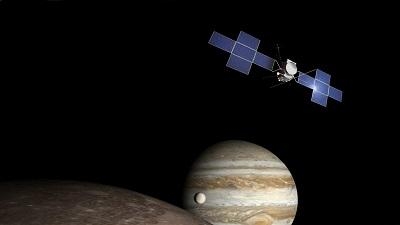Mon, Aug 03, 2015
Now That A Spacecraft Has Explored The 'Dwarf Planet,' Pluto, ESA Is Headed For The 'Mega Planet,' Jupiter
The European Space Agency (ESA) has selected Airbus Defence and Space as the prime contractor to develop and build the JUICE (JUpiter ICy moons Explorer) spacecraft. JUICE is the first large mission of the ESA Cosmic Vision program, with a launch date in 2022.

“JUICE will address the question: are there current habitats outside Earth in the Solar System with the necessary conditions to sustain life?” said François Auque, Head of Space Systems. “To answer this, we will develop and manufacture a fantastic spacecraft, building on our unique expertise gained in previous unrivalled space exploration missions. After the Sun, Mercury, Venus, the Earth, Mars, Titan… and even a comet, our engineers’ next challenge is to build this sophisticated spacecraft to explore the Jupiter system.”
JUICE is the first European mission to Jupiter; its overarching theme is the emergence of habitable worlds around gas giants. JUICE will investigate the Jupiter system, with a focus on its icy moons and the possibly ocean-bearing worlds of Europa, Ganymede and Callisto. The mission will study the moons addressing two key themes: what are the conditions for planet formation and the emergence of life.
Following a launch on Ariane 5, JUICE will cruise for 7.5 years making extensive use of gravity assist maneuvers (in order to save fuel and energy) around the Earth, Mars and Venus before reaching the Jupiter system. After insertion into Jupiter’s orbit, JUICE will use multiple fly-bys to complete a comprehensive orbital tour over 3.5 years. At the end of the tour, JUICE will be set in orbit around Ganymede, becoming the first spacecraft ever to enter orbit around an icy satellite in the outer Solar System.
To fulfil its scientific mission, the spacecraft will carry 10 instruments covering a wide range of measurements techniques (optical, sub-millimeter, radar, magnetic electric, and plasma and particle sensors). To avoid any perturbation of the scientific instruments, the spacecraft will have an unprecedented level of magnetic cleanliness.
Weighing five and a half tons, JUICE will be powered by a large 97 m² solar generator, the largest ever built for an interplanetary mission. This will ensure the spacecraft produces enough energy even in the low solar environment at Jupiter.
(Image of the JUICE spacecraft provided by Airbus Defence)
More News
He Attempted To Restart The Engine Three Times. On The Third Restart Attempt, He Noticed That Flames Were Coming Out From The Right Wing Near The Fuel Cap Analysis: The pilot repor>[...]
Make Sure You NEVER Miss A New Story From Aero-News Network Do you ever feel like you never see posts from a certain person or page on Facebook or Instagram? Here’s how you c>[...]
From 2009 (YouTube Edition): Leading Air Show Performers Give Their Best Advice for Newcomers On December 6th through December 9th, the Paris Las Vegas Hotel hosted over 1,500 air >[...]
Aero Linx: NASA ASRS ASRS captures confidential reports, analyzes the resulting aviation safety data, and disseminates vital information to the aviation community. The ASRS is an i>[...]
“For our inaugural Pylon Racing Seminar in Roswell, we were thrilled to certify 60 pilots across our six closed-course pylon race classes. Not only did this year’s PRS >[...]
 NTSB Final Report: Rutan Long-EZ
NTSB Final Report: Rutan Long-EZ ANN FAQ: Turn On Post Notifications
ANN FAQ: Turn On Post Notifications Classic Aero-TV: ICAS Perspectives - Advice for New Air Show Performers
Classic Aero-TV: ICAS Perspectives - Advice for New Air Show Performers ANN's Daily Aero-Linx (06.28.25)
ANN's Daily Aero-Linx (06.28.25) Aero-News: Quote of the Day (06.28.25)
Aero-News: Quote of the Day (06.28.25)



